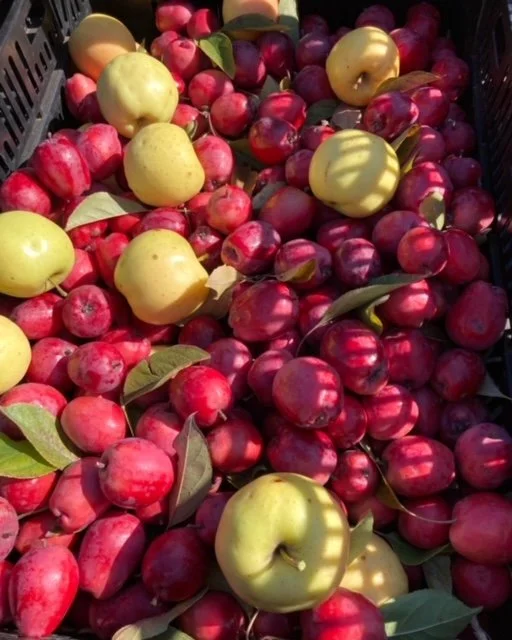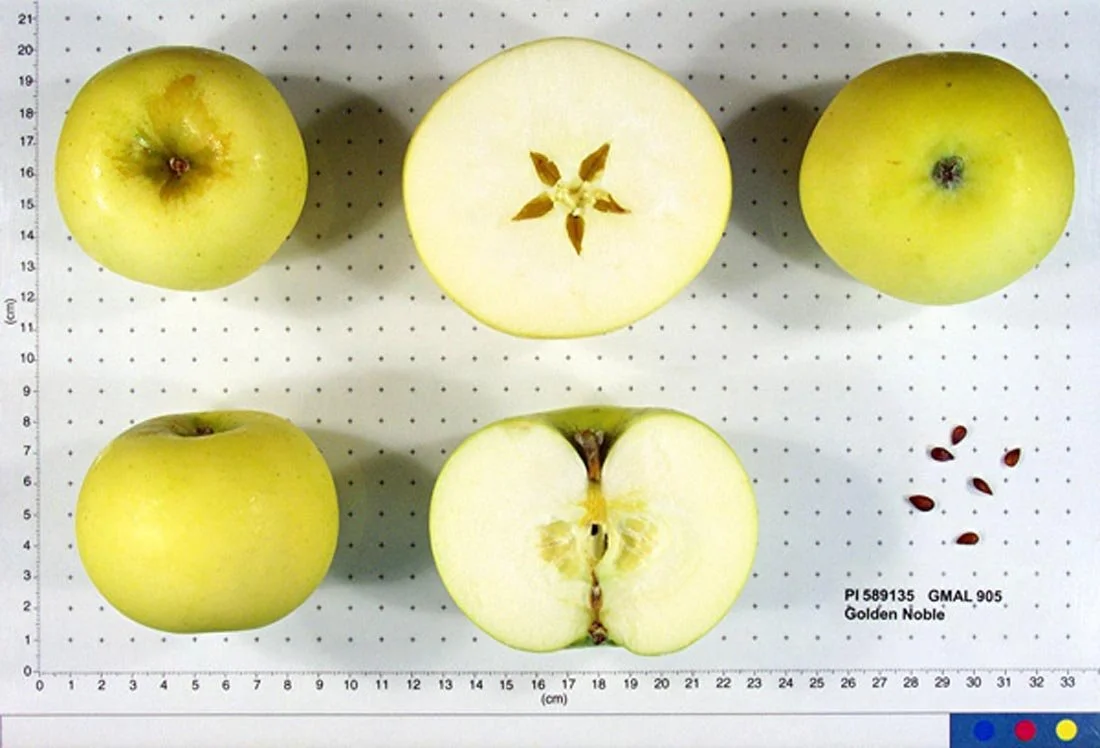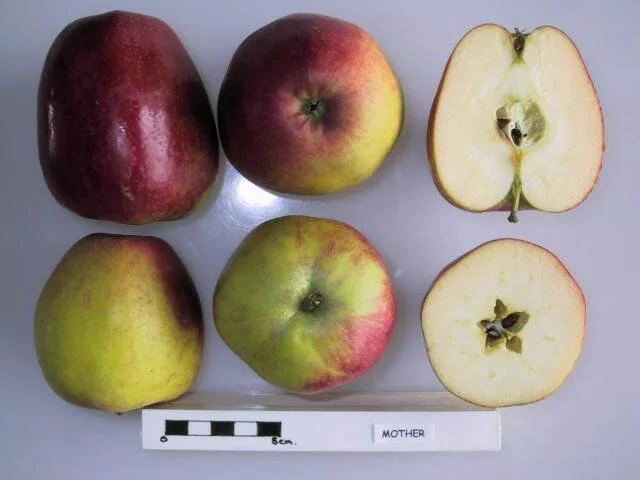Apple Scionwood
Welcome to our collection of apple scionwood. We grow over 130 varieties of apples and offer scions for grafting from most of them.
For filtered search - we have apples organized by categories and tags. Use the filter below to select as many categories and tags as you want to narrow down your search. For the most specific results, select just one category and multiple desired tags. Full functionality is coming soon - we are continuing to update each variety with all the correct categories and tags. Feel free to reach out with questions about specific varieties.
Categories:
Cider apples (good for hard ciders)
Dessert apples (also known as snacking apples, good for fresh eating)
Baking/saucing apples (also known as culinary apples, good for canning, preserving, baking, and cooking)
Red Flesh (red or pink flesh on the inside)
Tags:
Cold hardy (good for extreme cold or Northern climates)
Disease-resistant (has moderate to strong resistance to one or more common apple diseases)
Harvest period early, mid, or late
Heat or low-chill tolerant (good for extreme warmer or Southern climates)
Heavy producer
Pollination Groups A through E
Ordering is now open for this season. Order now for shipping between January and April 2025. Questions? Please contact Christina Fordyce at 503-930-8280 or fordycefarminc@gmail.com.
Scion wood is sold by the piece, except for some varieties that are available in bulk quantities of a 20-pack. We always seek to provide sticks that are close to 12” and pencil thickness at the base but every variety grows differently and so thickness varies.
We ship only within the United States. We do not ship internationally. Rootstock does not ship to California.
Return/Refund Policy: We do not offer returns or exchanges on scionwood or rootstock. We have a 30-day return policy on our clippers (must be unused and returned in original packaging. Return label must be requested). If we have made an error on the scionwood variety you have ordered, we will refund or replace the incorrect item. Claims for errors in your order must be presented within 30 days of receipt of your order. Claims must include a picture of the error and sent to us by email at fordycefarminc@gmail.com. Failure to assert claims within 30 days after order receipt renders this warranty null and void.

These are out of New England in the late 1700s. They have a powdery blue bloom. Their unique flavor has been described as tropical. Henry David Thoreau listed them as a favorite cultivated apple, being more like the wild ones. These have some disease resistance, are late season apples and fairly vigorous growers.
Categories: dessert apple, baking/saucing apple
Tags: Cold hardy, Harvest period late, Pollination Group C

From Geneva, New York 1898. It was bred by S.A. Bach, the author of the famous “Apples of New York.” It may be unfamiliar but it’s actually the 15th most commonly sold apple in the U.S. While these grow well in the eastern part of the country we find them to be slow growers, modest producers and not exceptional in any way. The scion is minimal and not likely to be very long or thick.
Categories: dessert apple
Tags: Pollination Group C, Disease-resistant, Harvest period mid, Cold hardy
These small apples are rather oval-shaped and the size of a golf ball or smaller. They are a nice deep red and have a bloom. These are sweet-sharp and a little bitter and is best used for jellies, as a sweet-sharp in ciders, or as an ornamental. (We will often use it in holiday centerpieces!) It originated in St. Petersburg, Russia in the 1890s. Its heavy pollen and long bloom period makes it an excellent pollinator for either home orchards or large scale operations.
Categories: cider apple, baking/saucing apple
Tags: Disease-resistant, Heavy producer, Harvest period mid, Cold hardy
These are intensely flavored late season apples. They are entirely russet covered. The trees are disease and pest resistant and are biannual bearers. The apples taste like an amazing, complex, cider and are quite tart. They also ferment into the most complex, single varietal cider we’ve made. It’s a classic English apple from the Victorian era. As a dessert apple they are quite tart, but I would eat them with a caramel sauce or served with a soft cheese and nuts to balance and mellow the strong flavor.
Categories: cider apple, dessert apple
Tags: Disease-resistant, Heavy producer, Cold hardy, Heat/low-chill tolerant, Harvest period late, Pollination Group C
A modern cross of the legendary Cox Orange Pippin with lots of the orange pippin flavor and better disease resistance. They are biennial bearers for us. We also don’t find them to be completely disease resistant though better than the Cox. From England and the 1970s.
Categories: dessert apple
Tags: Pollination Group C, Heavy producer, Harvest period mid, Cold hardy
An early, mild and slightly ginger flavored apple. These are noted not just for their flavor but the fact that they don’t brown. Related to the Golden Delicious and out of Virginia in the 1960s. In cooler summers, when they hang better, these are particularly delicious. Tip bearers.
Categories: dessert apples
Tags: Cold hardy, Harvest period early, Pollination Group A
We take Golden Delicious scion only from the oldest trees on our orchard. These large, standard, over 60 year old trees produce apples that are noticeably richer in flavor than the younger, under 20 year old, trees. It’s unclear if this is the result of genetic differences that come from years of selection or if the large, old trees access nutrients not available to the others. A dead, ripe Golden Delicious is an amazing apple and as commercial ones are picked much too early for any real flavor it’s only experienced by those with these historic trees.
Categories: dessert apple, cider apple, baking/saucing apple
Tags: Cold hardy, Harvest period late, Pollination Group D
This popular garden variety originated in the UK back in the 1800s. It is pale green to golden yellow and can be lightly russeted. Best used for pie or juice. Keeps for months in storage.
Categories: baking/saucing apple
Tags: Harvest period late, Cold hardy
A cross between Jonathan and Golden Delicious. Bred in New York in 1953. This is one of the more common commodity apples. Large, sweet, fairly mild fruit that are mid to late season ripening. They are fairly scab prone and so can be challenging for organic growers and wet climates.
Categories: dessert apple, cider apple
Tags: Heavy producer, Cold hardy, Harvest period late, Pollination Group D
The most well-known creation of Piet de Sonnaville and not that old, released in 1949. It’s a child of the Cox Orange Pippin but with a more aromatic nature. One of our absolute favorites. We love almost everything about this apple from its overall decent disease resistance to its productivity and its amazing flavor. We’ve had good results grafting this.
Categories: dessert apple, baking/saucing apple, cider apple
Tags: Disease-resistant, Heavy producer, Cold hardy, Heat/low-chill tolerant, Harvest period mid, Pollination Group D
These are very popular hard cider apples. They’re reasonably disease resistant and fairly vigorous growers. They are fairly biannual bearers. We have bulk quantities of these scion.
Categories: cider apple
Tags: Cold hardy, Pollination Group E, Harvest period late
These late season apples are often covered in what is referred to as warty russet. These are aromatic, earthy, sweet apples and the most delicious parts are under the warts. It's British from 1819 and is reasonably disease resistant.
Categories: dessert apple
Tags: Cold hardy, Harvest period late
This descendant of the Cox’s Orange Pippin has that Cox flavor with other subtle flavors like anise. It’s a great fresh eating apple. Developed by Laxton Brothers Nursery in England in the 1890s. Medium apple with a green base and dark red blush. Can tend biennial but has a heavy crop in the on years.
Categories: dessert apple
Tags: Pollination Group D, Disease-resistant, Heavy producer, Harvest period mid, Cold hardy
The earliest apples in our orchard. They usually ripen by the second week in July. These large green apples are very different than most others. They are light and airy, very tart without the depth that rounds out later tart apples. They make a fast sauce and are one of the best apples for fritters or other quick cooking recipes.
Categories: baking/saucing apple
Tags: Cold hardy, Pollination Group C, Harvest period early
A lovely, early baking apple. Lots of disease resistance and large apples even in less than perfect conditions. The flavor is tart but yet somewhat delicate. The trees are slow growing and so we always have just a handful of scion.
Categories: baking/saucing apple
Tags: Cold hardy, Disease-resistant, Heavy producer, Harvest period early
Lyman’s Large Summer: It’s odd for an early apple to have the depth of flavor of the Lyman’s and that’s why they were incredibly popular 150 years ago. These apples tend to be tart by today's standards. These are somewhat disease resistant but prone to scab and blight.
Categories: baking/saucing apple, dessert apple
Tags: Pollination Group D, Cold hardy, Harvest period early
These well known traditional apples are popular for a reason. Their bright red skin, tender white flesh and aromatic, sweet, tart flavor makes them a favorite. We wish we had the kind of cool nights needed to bring out their best flavors in the fall but some years they’re amazing even here. Somewhat scab prone in wet climates. Tends somewhat biennial.
Categories: cider apple, dessert apple
Tags: Pollination Group B, Disease-resistant, Harvest period mid, Cold hardy
These very early season dessert apples come from Arkansas. The apples are large and the trees are productive but they are scab prone and quick to drop. These are Monark, with a K. These are a different variety than the Monarch, ending in CH.
Categories: dessert apple
Tags: Heavy producer, Cold hardy, Harvest period early, Southern US roots
This apple of unknown parentage originated on the farm of General Stephen Gardner in Worcester County in Massachusetts. It’s biennial and wants very specific growing conditions. We only have one tree in the entire orchard so don’t often have the scionwood for sale. It’s delicious for fresh eating and also known to be good in a pie.
Categories: dessert apple, baking/saucing apple
Tags: Harvest period mid, Cold hardy, Pollination Group D
These famous, still relatively common, apples came out of New York in 1800. They were among the first apple varieties brought to Oregon and they grow nicely here. A mild, late season apple that stores well.
Categories: baking/saucing apple, dessert apple
Tags: Harvest period late, Pollination Group E, Cold hardy

Red Spy: a redder sport of the more common Northern Spy. These late ripening, long keeping apples were developed in New York in the 1840s. Whereas Northern Spy apples have some green background to the skin these are all red.
Categories: baking/saucing apple, dessert apple
Tags: Harvest period late, Pollination Group E, Cold hardy

Legendary bitter, cider apple. These are entirely bi-annual, very resistant to disease and almost never attacked by insects. They are vigorous growers. The scionwood tends to be thicker than a pencil. We’ve had much success grafting these. We have these in bulk quantities.
Categories: cider apple
Tags: Harvest period late, Pollination Group B, Disease-resistant, Heavy producer, Cold hardy

This small late season apple has dark red flesh and a lovely sweet tart taste. Good for eating, winter decorating, fine apple jellies and preserves. Trees are lovely when in bloom and in fall with bright red fruits. Ours tend to have darker red flesh than many pictures of “Winter Red Flesh” we see online. Typically these trees produce very little scionwood. Tends biennial.
Categories: Red flesh, dessert apple, baking/saucing apple
Tags: Harvest period late, Cold hardy
Airlie Red Flesh
Akane
Alexander (Aporte)
Alkmene
Almata, (red flesh)
Ambrosia
Amere de Berthecourt
Anna
Arkansas Black
Ashmead's Kernel
Baldwin
Belle de Boskoop
Berner Rosen
Blairmont
Blenheim Orange
Blue Pearmain
Braeburn
Bramley Seedling
Calville Blanc d'Hiver
Cameo
Centennial
Chehalis
Coles Quince
Corail (Pinova & Pinata)
Cornish Gillflower
Cortland
Cox's Orange Pippin
Dabinett
Devonshire Crimson Queen
Discovery
Dolgo
Duchess of Oldenberg
Dumelow's Seedling
Empire
Enterprise
Egremont Russet
Erwin Bauer
Esopus Spitzenberg
Fiesta
Foxwhelp/Fauxwhelp
Fuji - jubilee
Fuji - yataka
Gala
Giant Russian Crab
Gingergold
Glockenapfel
Gold Rush
Golden Delicious
Golden Noble
Granny Smith
Gravenstein
Grimes Golden
Hauer Pippin
Hawkeye
Herefordshire Redstreak
Hidden Rose, (red flesh)
Holstein
Honeycrisp
Hubbardston Nonsuch
Jonagold
Jonathan
Karmijn de Sonnaville
Kerr Crab
King of Tompkins
Kingston Black
Knobbed Russet
Lady
Lady Williams
Laxton Superb
Liberty
Lodi
Lubsk Queen
Lyman's Large Summer
Major Apple
McIntosh
Melrose
Mollie’s Delicious
Monark
Mother
Muscadet de Dieppe
Mutsu
Newtown Pippin
Niedzwetzkyana (red flesh)
Northern Spy
Opalescent
Oriole
Orleans Reinette
Parentene
Peasgood Nonsuch
Pierce Pasture
Pink Pearl
Porter’s Perfection
Queen Bee
Queen Cox
Queener Donut
Red Gravenstein
Red Spy
Redfree
Reverend W. Wilkes
Ribston Pippin
Rubinette
Rusty Coat
Sansa
Scarlet Surprise
Sekai Ichi
Senshu
St. Edmunds Pippin
Starr
Summer Rambo
Sundance
Suncrisp
Surprise
Sweet Delicious
Tremblett's Bitter
Washed Russet
Whitney crab
Wickson
Williams Pride
Winter Red Flesh
Wynoochee Early
Yarlington Mill
Yellow Bellflower
York
Zabergau Reinette
20 oz.




















From the Netherlands of the 1850s. We’re super fans of these apples. They start out tart but age into a true nutty but intensely apple flavor. These also make a fantastic single varietal hard cider. The trees are productive and highly disease resistant. They are vigorous growers and graft easily. The apples are fantastic eaten fresh, baked or fermented. We think these should be on every homestead and in every commercial orchard.
Categories: dessert apple, cider apple, baking/saucing apple
Tags: Disease-resistant, Heavy producer, Cold hardy, Harvest period mid, Pollination Group C